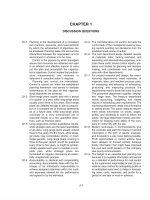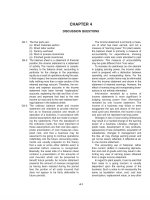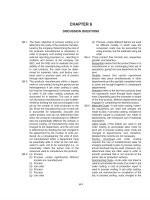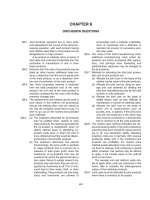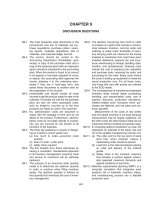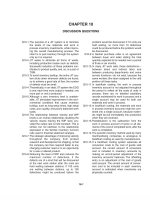Solution manual cost accounting by carter 14e ch19
Bạn đang xem bản rút gọn của tài liệu. Xem và tải ngay bản đầy đủ của tài liệu tại đây (63.45 KB, 26 trang )
CHAPTER 19
DISCUSSION QUESTIONS
Q19-1. When standard costs are not incorporated,
they may be used for the purposes of pricing,
budgeting, and controlling cost; but if they are
not used for inventory costing, the advantages from the saving of clerical effort in
accounting cannot be obtained.
Q19-2. With actual cost methods, it is first necessary
to select a cost flow method—lifo, fifo, average, etc. It is then necessary to keep detailed
records of quantities and prices and to make
fairly complex calculations of inventory costs.
With a standard costing system, only quantities, not prices, must be taken into account,
facilitating both record keeping and calculations. Standard costs also provide cost control.
Q19-3. The number of variance accounts is determined by (a) the number and type of variances that are to appear in statements for
management use, and (b) the need for easy
disposal of variances at the end of the fiscal
period, particularly when the variances are
not treated uniformly in financial statements
and for analyses.
Q19-4. (a) The standard cost of products completed
and products sold can be determined
immediately without waiting for the actual
cost to be calculated. With standard
costs, monthly statements can be prepared more quickly.
(b) A firm producing a great many different
products finds it practically impossible to
determine the actual cost of each product. The use of standard costs will facilitate the preparation of income statements
by product lines.
(c) Keeping finished goods stock records in
quantities only will result in clerical saving, since this eliminates the necessity for
recording the actual unit cost of each
receipt and issue or shipment.
Q19-5. The standard costing of inventories depends
on (a) the types of standards employed, (b)
the degree of success that the company has
in keeping overall actual costs in line with
standard costs, and (c) the concept held with
regard to the most suitable kind of cost.
Q19-6. (a) Deferral of variances is supported on the
grounds that, if the standards in use are
based on normal price, efficiency, and
output levels, positive and negative variances can be expected to offset one
another in the long run. Because variance
account balances at any given point in
time are due to recurring seasonal and
business cycle fluctuations, and because
periodic reporting requirements result in
arbitrary cutoff dates, variance account
balances at a particular cutoff date are
not assignable to operating results of the
period then ended. They will cancel out
over time and therefore should be carried
to the balance sheet.
(b) Variances appearing as charges or credits on the income statement are regarded
as appropriate charges or credits in the
period in which they arise. They are considered the result of favorable or unfavorable departures from normal (standard)
conditions and are disclosed separately
from cost of goods sold at standard. This
provides management with unobscured
information for immediate corrective
action.
Inventory costs and cost of goods
sold should not be distorted by variances
that represent abnormal efficiencies or
inefficiencies. The standard cost represents that amount which is reasonably
necessary to produce finished products
and should therefore be considered the
best measure of the cost of goods manufactured and inventory cost, as long as
the underlying operating conditions
remain unchanged.
(c) The argument for allocating variances
between inventories and cost of goods
sold is that standard costs are a useful
tool for purposes of managerial control,
but should not be substitutes for actual
historical costs in the financial statements. Only actual historical costs should
be used for financial reporting, even
19-1
19-2
Chapter 19
though they are greater or less than
standard costs, and without regard to the
reasons for their differences from standard costs. Standard cost variances are
not gains or losses but costs (or reductions therein) of goods manufactured
and should be allocated between inventories and cost of goods sold. To treat
them as gains or losses in the period in
which they arise distorts both the inventory and gross profit figures. This distortion will be even greater if the standards
are lacking in accuracy or reliability.
Further, to substitute standard costs for
actual historical costs in the financial
statements represents an unwarranted
sacrifice of objectivity.
Chapter 19
19-3
EXERCISES
E19-1
Price variance recorded at the time materials are received and placed in the storeroom:
Materials (20,000 × $.42) ................................................
Materials Purchase Price Variance (20,000 × $.02) .....
Accounts Payable (20,000 × $.44) ...........................
8,400
400
Work in Process (8,200 × 2 × $.42) ...............................
Materials Quantity Variance (100 × $.42)......................
Materials (16,500 × $.42) ..........................................
6,888
42
8,800
6,930
Materials recorded at actual cost when received, and price variance determined at the
time materials are issued to production:
Materials (20,000 × $.44) ................................................
Accounts Payable.....................................................
8,800
Work in Process (8,200 × 2 × $.42) ...............................
Materials Price Usage Variance (16,500 × $.02)...........
Materials Quantity Variance (100 × $.42)......................
Materials (16,500 × $.44) ..........................................
6,888
330
42
8,800
7,260
Price variance determined when the materials are received, but not charged to production until the materials are actually placed in process:
Materials (20,000 × $.42) ................................................
Materials Purchase Price Variance (20,000 × $.02) .....
Accounts Payable (20,000 × $.44) ...........................
8,400
400
Work in Process (8,200 × 2 × $.42) ...............................
Materials Quantity Variance (100 × $.42)......................
Materials (16,500 × $.42) ..........................................
6,888
42
Materials Price Usage Variance (16,500 × $.02)...........
Materials Purchase Price Variance .........................
330
Materials (12,000 AQ purchased × $8 SP)....................
Materials Purchase Price Variance ...............................
Accounts Payable.....................................................
96,000
960
Work in Process (12,800 SO × $8 SP) .........................
Materials Quantity Variance .........................................
Materials (13,000 AQ issued × $8 SP) ....................
102,400
1,600
8,800
6,930
330
E19-2
(1)
96,960
104,000
19-4
Chapter 19
E19-2 (Concluded)
(2)
Average costing
Beginning inventory.....................
Purchases ...................................
Available for use...........................
(3)
(4)
Total Cost
$ 15,880
96,960
112,840
Quantity
2,000
12,000
14,000
Unit
Cost
$7.94
8.08
8.06 average
Materials ..........................................................................
Accounts Payable.....................................................
96,960
Work in Process (12,800 SQ × $8 SP) ..........................
Materials Quantity Variance ((13,000 – 12,800) × $8 SP)
Materials Price Usage Variance (13,000 AQ ×
($8.06 AP – $8 SP)).............................................
Materials (13,000 AO × $8.06 AP)............................
102,400
1,600
Fifo inventory
Work in Process (same as above) ................................
Materials Quantity Variance (same as above) .............
Materials Price Usage Variance ....................................
Materials (($7.94 × 2,000 units) +
($8.08 × 11,000 units)) ........................................
Lifo inventory
Work in Process (same as above) ................................
Materials Quantity Variance (same as above) .............
Materials Price Usage Variance ....................................
Materials (($8.08 × 12,000 units) +
($7.94 × 1,000 units)) ..........................................
96,960
780
104,780
102,400
1,600
760
104,760
102,400
1,600
900
104,900
E19-3
Payroll..............................................................................
Accrued Payroll ........................................................
18,144
Work in Process (2,400 × 3/4 × $9.50) ..........................
Labor Efficiency Variance (120 × $9.50) .......................
Labor Rate Variance (1,920 × $.05) .........................
Payroll (1,920 × $9.45) ..............................................
17,100
1,140
18,144
96
18,144
Chapter 19
19-5
E19-4
Work in Process
(10,000 units × 2 SQ per unit × $2 SP) .............
Materials Price Variance
(($2.02 AP – $2 SP) × 21,000 AQ)......................
Materials Quantity Variance
($2 SP × (20,000 SQ – 21,000 AQ))....................
Materials (21,000 AQ × $2.02 AP) ...........................
Work in Process
(10,000 units × 1/4 SH per unit × $12 SR) ........
Labor Rate Variance
(($12.20 AR – $12 SR) × 2,425 AH) ...................
Labor Efficiency Variance
($12 SR × (2,425 AH – 2,500 SH))......................
Payroll (2,425 AH × $12.20 AR) ...............................
40,000
420
2,000
42,420
30,000
485
900
29,585
E19-5
(1)
(2)
(3)
Work in Process ($7 FO rate × 12,000 SH)...................
Applied Factory Overhead.......................................
84,000
Applied Factory Overhead.............................................
Factory Overhead Control .......................................
84,000
Volume Variance
($4.50 fix. rate × (15,000 BH – 12,000 SH)) .......
Controllable Variance ...............................................
Factory Overhead Control
($88,800 actual – $84,000 applied)....................
84,000
84,000
13,500
8,700
4,800
E19-6
(1)
(2)
(3)
(4)
Factory Overhead Control .............................................
Various Credits .........................................................
55,900
Work in Process (11,000 SH × $5 FO rate)...................
Applied Factory Overhead .....................................
55,000
Applied Factory Overhead.............................................
Factory Overhead Control .......................................
55,000
Controllable Variance .....................................................
Volume Variance
($2 fix. rate × (10,000 BH – 11,000 SH)) ............
Factory Overhead Control
($55,900 actual – $55,000 applied)....................
2,900
55,900
55,000
55,000
2,000
900
19-6
Chapter 19
E19-7
(1)
(2)
(3)
Work in Process (4,800 SH × $16 FO rate)...................
Applied Factory Overhead.......................................
76,800
Applied Factory Overhead.............................................
Factory Overhead Control .......................................
76,800
Variable Efficiency Variance
($4 var. rate × (5,200 AH – 4,800 SH)) ...............
Volume Variance
($12 fix. rate × (5,000 BH – 4800 SH)) ..............
Spending Variance ...................................................
Factory Overhead Control
($77,800 actual – $76,800 applied)....................
76,800
76,800
1,600
2,400
3,000
1,000
E19-8
(1)
(2)
(3)
Work in Process (7,000 SH × $11 FO rate)...................
Applied Factory Overhead.......................................
77,000
Applied Factory Overhead.............................................
Factory Overhead Control .......................................
77,000
Variable Efficiency Variance
($8 var. rate × (7,600 AH – 7,000 SH)) ...............
Volume Variance
($3 fix. rate × (8,000 OH – 7,000 SH))................
Spending Variance .........................................................
Factory Overhead Control
($87,900 actual – $77,000 applied)....................
77,000
77,000
4,800
3,000
3,100
10,900
Chapter 19
19-7
E19-9
Percentage of current-year labor cost element in finished goods and cost of goods
sold:
Amount
%
Finished goods, 19,000 units × $4 labor ......................
$ 76,000
20
Cost of goods sold (from current production),
(91,000 units – 15,000 units) × $4 labor .................
304,000
80
$380,000
100
Allocation of current-year labor variances:
Finished goods ($52,000 × 20%) .................................
Cost of goods sold ($52,000 × 80%)...........................
$10,400
41,600
$52,000
End-of-year balances:
Finished
Cost of
Goods Goods Sold
$171,000
$819,000
10,400
41,600
Balance at standard ..................................................................
Current year’s labor variances allocation...............................
Last year’s variances, all applicable to cost of goods
sold on a fifo flow assumption ..........................................
$181,400
5,800
866,400
E19-10
Percentage of units in inventories and cost of goods sold:
Account
Work in Process ...........................................
Finished Goods ............................................
Cost of Goods Sold......................................
Total ...............................................................
Materials
Units
%
1,500
25%
1,200
20%
3,300
55%
6,000
100%
Direct Labor and
Factory Overhead
Units
%
500
10%
1,200
24%
3,300
66%
5,000
100%
Allocation of variances:
Variance
Materials purchase price ...........
Materials quantity.......................
Labor rate....................................
Labor efficiency..........................
Controllable.................................
Volume .......................................
Total .............................................
Total
Amount
$ (150.00)
500.00
600.00
1,200.00
1,500.00
(1,800.00)
$ 1,850.00
Work in
Process
$ (37.50)
125.00
60.00
120.00
150.00
(180.00)
$ 237.50
Finished
Goods
$ (30.00)
100.00
144.00
288.00
360.00
(432.00)
$ 430.00
Cost of
Goods
Sold
$ (82.50)
275.00
396.00
792.00
990.00
(1,188.00)
$ 1,182.50
19-8
Chapter 19
E19-11 APPENDIX
Work in Process ($4 FO rate × 3,450 units × 1.5 SH per unit)
Applied Factory Overhead .................................................
20,700
Applied Factory Overhead .......................................................
Efficiency Variance ($4 FO rate × (5,320 AH – 5,175 SH)) .....
Idle Capacity Variance ($3 fix. rate × (6,000 OH – 5,320 AH))
Spending Variance ..............................................................
Factory Overhead control ..................................................
20,700
580
2,040
20,700
2,920
20,400
E19-12 APPENDIX
Work in Process ($20 FO rate × 9,400 SH) .............................
Applied Factory Overhead .................................................
188,000
Applied Factory Overhead .......................................................
Variable Efficiency Variance
($4.50 var. × (10,600 AH – 9,400 SH))...........................
Fixed Efficiency Variance
($15.50 fix. × (10,600 AH – 9,400 SH)) .........................
Spending Variance ..............................................................
Idle Capacity Variance
($15.50 fix. × (10,000 BH – 10,600 AH)) .......................
Factory Overhead Control..................................................
188,000
188,000
5,400
18,600
7,200
9,300
195,500
Chapter 19
19-9
PROBLEMS
P19-1
Materials (33,000 AQ purchased × $2 SP) .............................
Materials Purchase Price Variance ....................................
Accounts Payable (33,000 AQ purchased × $1.94 AP) ....
66,000
Work in Process (6,000 equivalent units × 6 SQ × $2 SP) ....
Materials Quantity Variance .....................................................
Materials (40,000 AQ issued × $2 SP).........................
72,000
8,000
Work in Process (5,800 equivalent units × 1/4 SH × $8 SR).....
Labor Rate Variance (($8.20 AR – $8 SR) × 1,500 AH)...........
Labor Efficiency Variance ($8 SR × (1,500 AH – 1,450 SR)) ....
Payroll ($8.20 AR × 1,500 AH) ............................................
11,600
300
400
Factory Overhead Control........................................................
Various Credits....................................................................
67,250
Work in Process
(5,500 equivalent units × 3/4 SH × $16 FO rate).........
Applied Factory Overhead .................................................
1,980
64,020
80,000
12,300
67,250
66,000
66,000
Applied Factory Overhead ......................................................
Controllable Variance................................................................
Volume Variance ($12 fixed rate × (4,000 BH – 4,125 SH))
Factory Overhead Control .................................................
66,000
2,750
Finished Goods (5,200 units × $26 standard cost)................
Work in Process ..................................................................
135,200
Accounts Receivable (5,500 units × $40 sales price)............
Sales .....................................................................................
220,000
Cost of Goods Sold (5,500 units × $26 standard cost) .........
Finished Goods ...................................................................
143,000
1,500
67,250
135,200
220,000
143,000
19-10
Chapter 19
P19-2
Materials
2,400
300
Labor
2,400
300
Overhead
2,400
300
2,100
2,100
2,100
0
200
2,300
100
80
2,280
150
50
2,300
5 units
3/4 DLH
2 MH
11,500
1,710
4,600
Materials (11,000 AQ purchased × $6 SP) ..............................
Materials Purchase Price Variance ..........................................
Accounts Payable................................................................
66,000
900
Work in Process ($6 SP × 11,500 SQ allowed) ......................
Materials Quantity Variance ....................................................
Materials ($6 SP × 12,000 AQ issued) ...............................
69,000
3,000
Work in Process ($12 SR × 1,710 SH allowed) .......................
Labor Rate Variance ($12.10 AR – $12 SR) × 1,700 AH) ........
Labor Efficiency Variance
($12 SR × (1,700 AH – 1,710 SH)) ................................
Payroll .................................................................................
20,520
170
Factory Overhead Control........................................................
Various Credits....................................................................
67,700
Work in Process ($14 FO rate × 4,600 SH allowed) ...............
Applied Factory Overhead .................................................
64,400
Applied Factory Overhead .......................................................
Variable Efficiency Variance
($2.80 var. rate* × (4,900 AH – 4,600 SH)) ...................
Volume Variance ($11.20 fix rate** × (5,000 SH – 4,600 SH)).
Spending Variance ..............................................................
Factory Overhead Control..................................................
64,400
Units completed and transferred out this period .
Less all units in beginning inventory..................
Equivalent units started and completed this
period ...............................................................
Add equivalent units required to complete
beginning inventory ........................................
Add equivalent units in ending inventory...........
Equivalent units of production this period.........
Multiply by standard quantity of input per unit
of product.........................................................
Standard quantity of input allowed for work
produced during the period ...........................
*$14 FO rate × 20% variable = $2.80 variable rate
**$14 FO rate – $2.80 variable rate = $11.20 fixed rate
66,900
72,000
120
20,570
67,700
64,400
840
4,480
2,020
67,700
Chapter 19
19-11
P19-3
Units completed and transferred out this period........
Less all units in beginning inventory...........................
Equivalent units started and completed this period ..
Add equivalent units required to complete
beginning inventory...........................................
Add equivalent units in ending inventory....................
Equivalent units of production this period..................
Multiply by standard quantity of input per unit
of product ..........................................................
Standard quantity of input allowed for work
produced during the period..............................
Materials
5,000
3,000
2,000
Conversion
Cost
5,000
3,000
2,000
0
2,000
4,000
2,000
1,500
5,500
6 units
1/2 hour
24,000
2,750
Materials ($.50 SP × 30,000 AQ purchased) ...........................
Materials Purchase Price Variance ..........................................
Accounts Payable................................................................
15,000
1,000
Work in Process ($.50 SP × 24,000 SQ allowed) ....................
Materials Quantity Variance .....................................................
Materials ($.50 SP × 24,500 AQ issued) ............................
12,000
250
Work in Process ($10 SR × 2,750 SH allowed) .......................
Labor Rate Variance (($10.75 AR – $10 SR) × 2,600 AH used).
Labor Efficiency Variance
($10 SR × (2,600 AH – 2,750 SH)) ................................
Payroll ($10.75 AR × 2,600 AH used).................................
27,500
1,950
Work in Process ($12 FO rate × 2,750 SH allowed) ...............
Applied Factory Overhead .................................................
33,000
Factory Overhead Control........................................................
Various Credits .............................................................
31,000
Applied Factory Overhead ......................................................
Controllable Variance................................................................
Volume Variance ($9 fixed rate × (2,500 BH – 2,750 SH)) ..
Factory Overhead Control..................................................
33,000
250
16,000
12,250
1,500
27,950
33,000
31,000
2,250
31,000
19-12
Chapter 19
P19-3 (Concluded)
Finished Goods Inventory (5,000 units × $14 standard cost*).
Work in Process...................................................................
*Materials (6 units @ $.50 each) ...........................
Labor (1/2 hour @ $10 per hour) ........................
Overhead: Variable (1/2 hour @ $3 per hour) ....
Fixed (1/2 hour @ $9 per hour) .......
Total standard cost per unit of product .............
70,000
70,000
$ 3.00
5.00
1.50
4.50
$14.00
Cost of Goods Sold (5,100 units × $14 standard cost) .........
Finished Goods Inventory..................................................
71,400
71,400
Accounts Receivable (5,100 units × $22 sales price)............
112,200
Sales .....................................................................................
112,200
CGA-Canada (adapted). Reprint with permission.
P19-4
LEESVILLE CORPORATION
Income Statement
For Year Ended December 31, 20A
Sales ((20,000 units + 110,000 units – 12,000 units) × $25)........................
Cost of goods sold at standard (118,000 units × 17.60) .............................
Gross profit at standard.................................................................................
Add net manufacturing variance...................................................................
Gross profit, adjusted to actual.....................................................................
Less marketing and administrative expenses .............................................
Operating income ...........................................................................................
1Manufacturing
variances:
Materials:
Purchase price .............................................................
Quantity ........................................................................
Labor:
Rate ...............................................................................
Efficiency ......................................................................
Factory overhead:
Controllable ..................................................................
Volume ..........................................................................
Unfavorable Favorable
$3,750
$15,000
25,760
44,000
8,000
$48,760
Net favorable variance.......................................................
$2,950,000
2,076,800
$ 873,200
901
$ 873,290
680,500
$ 192,790
1,100
$48,850
48,760
$
90 fav.
Chapter 19
19-13
P19-4 (Continued)
Computation of manufacturing variances:
Materials:
Actual quantity × average cost
(250,000 lbs. × 1.485 per lb.)....................................
Actual quantity × standard cost
(250,000 lbs. × $1.50 per lb.)....................................
Materials purchase price variance................................
Transferred into production (240,000 lbs. × $1.50) .....
Standard quantity for 115,000* equivalent production
units (230,000 lbs. × $1.50 per lb., or 115,000 units
× $3 per unit).............................................................
Materials quantity variance .........................................
$371,250
375,000
$ (3,750) fav.
$360,000
345,000
$ 15,000 unfav.
*Computation of equivalent production for materials:
Transferred out of work in process ..............................
Beginning inventory (all completed) ............................
Started and completed this period...............................
Add ending inventory ....................................................
Total ...........................................................................
Pound
Basis
220,000
20,000
200,000
30,000
230,000
Labor:
Actual labor cost ............................................................
Actual hours × standard labor rate (161,000 hours × $8)
Labor rate variance ........................................................
$1,313,760
1,288,000
$25,760 unfav.
Actual hours × standard labor rate ..............................
Standard hours × standard labor rate (166,500 hrs.** ×
$8 per hour, or 111,000 units ** × $12 per unit).....
Labor efficiency variance ..............................................
Unit
Basis
110,000
10,000
100,000
15,000
115,000
$1,288,000
1,332,000
$ (44,000) fav.
19-14
Chapter 19
P19-4 (Concluded)
**Computation of equivalent production for labor and factory overhead:
Transferred out of work in process ..............................
Beginning inventory—work in process........................
Started and completed this period...............................
Add 3/5 to complete beginning inventory....................
Add 1/3 of ending inventory..........................................
Total ...........................................................................
Hour
Basis
165,000
15,000
150,000
9,000
7,500
166,500
Unit
Basis
110,000
10,000
100,000
6,000
5,000
111,000
Factory overhead (two-variance method):
Actual factory overhead ..........................................................
Budget allowance:
Variable overhead (111,000 units × $1.50)
$166,500
Fixed overhead...........................................
121,000
Controllable variance ...............................................................
Budget allowance.....................................................................
Applied factory overhead (111,000 units × $2.60).................
Volume variance ......................................................................
$295,500
287,500
$8,000 unfav.
$287,500
288,600
$ (1,100) fav.
P19-5
KALMAN COMPANY
Interim Income Statement
For the Second Quarter, 20—
Sales (600,000 × $30) ...............................................................
Cost of goods sold at standard (500,000 × $18) ...................
Gross profit at standard ..........................................................
Adjustments for standard cost variances:
$237,600
Materials price variance1 ...........................
36,000
Labor efficiency variance2 ........................
3
135,000
Overhead spending variance ..................
8,000
Variable overhead efficiency variance4....
5
0
Overhead volume variance ......................
Adjusted gross profit ...............................................................
Less commercial expenses:
Marketing expenses ($18,000,000 × 10%) ..
$1,800,000
Administrative expenses ($6,000,000 × 25%) 1,500,000
Income before income tax.......................................................
Less income tax expense ($3,483,400 ×
($3,750,000 / $7,500,000))...................................................
Net income ................................................................................
$18,000,000
10,800,000
$ 7,200,000
416,600
$ 6,783,400
3,300,000
$ 3,483,400
1,741,700
$1,741.700
Chapter 19
19-15
P19-5 (Continued)
1The
materials price variance should be prorated between work in process, finished
goods, and cost of goods sold as follows:
Ending balance of
work in process
=
$72, 000
=
$18 per unit
4, 000 units
Ending balance of
finished goods
=
$900, 000
=
$18 per unit
50, 000 units
Total units in ending inventories ..................................
Total units produced during second quarter ..............
Total units in ending inventories ..................................
Units produced and sold during second quarter........
___
54,000 units
450,000
54,000
396,000
396, 000
Materials price variance charged
=
× 270, 000 = $237, 600
to cost of goods sold
450,0
000
2 Since
the labor efficiency variance is not regarded as significant, all of it is charged
against second quarter income.
3A
portion of the overhead spending variance is attributable to the overtime premium
paid. Since the overtime premium was incurred in order to meet sales forecasts for
the entire year, the portion of the spending variance resulting from the overtime premium ($9.00 labor per unit at regular rate × 50% = $4.50/unit) should be prorated over
the entire year in proportion to the sales of each quarter as follows:
Production in excess of capacity (Quarters 1 and 2 only):
Quarter 1 = 465,000 – 430,000 = 35,000 units
Quarter 2 = 450,000 – 430,000 = 20,000 units
Overtime premium resulting from excess production:
Quarter 1 = 35,000 units × $4.50/unit =
$157,500
Quarter 2 = 20,000 units × $4.50/unit =
90,000
Total overtime premium for first six months
$247,500
Proration of overtime premium portion of spending variance based on sales:
Quarter 2 =
$600,000 × $247,500 total overtime premium = $99,000
$1,500,000
19-16
Chapter 19
P19-5 (Concluded)
The overhead spending variance charged against second quarter income is calculated as follows:
Total overhead spending variance for second quarter ...........................
Amount resulting from second quarter overtime premium....................
Amount related to unexpected inefficiencies ..........................................
Amount of overtime premium chargeable to second quarter on
the basis of sales allocation determined above ................................
Total spending variance charged against second quarter income
$126,000
90,000
$36,000
99,000
$135,000
4 Since
factory overhead is charged to production on the basis of direct labor hours, an
unfavorable variable overhead efficiency variance occurs because of the inefficient
use of direct labor. The amount of the unfavorable overhead variable efficiency variance is determined as follows:
$36, 000
Labor efficiency variance
× $2 = 8, 000
× Variable overhead per unit =
$9
Labor cost per unit
5 The
company policy is to report a volume variance on interim statements only if actual
production differs from the planned production schedule. Since actual production is
equal to budgeted production through the end of the second quarter, there is no volume variance to be charged against second quarter income.
P19-6
(1)
Units completed and transferred out .........
Less beginning inventory (all units)...........
Started and completed this period.............
Add work this period in inventories:
Beginning inventory...............................
Ending inventory ....................................
Equivalent units of Westco..........................
Standard quantity per unit of Westco ........
Standard quantity allowed...........................
Material
A
15,000
6,000
9,000
Material
B
15,000
6,000
9,000
Labor
15,000
6,000
9,000
Factory
Overhead
15,000
6,000
9,000
0
5,000
14,000
×
1
14,000
2,000
2,500
13,500
×
6
81,000
3,000
1,250
13,250
× 1/2
6,625
2,000
2,500
13,500
× 1/3
4,500
Materials ((15,000 × $14) + (80,000 × $2)) ...............................
Materials Purchase Price Variance ..........................................
Accounts Payable ((15,000 × $13) + (80,000 × $3)) ..........
370,000
65,000
Work in Process ((14,000 × $14) + (81,000 × $2)) ...................
Materials Quantity Variance .....................................................
Materials ((14,200 × $14) + (82,300 × $2)) .........................
358,000
5,400
435,000
363,400
Chapter 19
19-17
P19-6 (Concluded)
Work in Process (6,625 × $10) .................................................
Labor Rate Variance (6,500 × ($10 – $11)) ..............................
Labor Efficiency Variance ((6,625 – 6,500) × $10) ............
Payroll (6,500 × $11)............................................................
66,250
6,500
Work in Process (4,500 × $27) .................................................
Applied Factory Overhead .................................................
121,500
Applied Factory Overhead .......................................................
Volume Variance ((5,000 – 4,500) × $24)..................................
Spending Variance ..............................................................
Variable Efficiency Variance ((4,500 – 4,400) × $3) ..........
Factory Overhead Control..................................................
121,500
12,000
1,250
71,500
121,500
11,200
300
122,000
(2)
Labor Efficiency Variance.........................................................
Spending Variance ....................................................................
Variable Efficiency Variance .....................................................
Income Summary .....................................................................
Materials Purchase Price Variance ....................................
Materials Quantity Variance ...............................................
Labor Rate Variance............................................................
Volume Variance ..................................................................
(3)
1,250
11,200
300
76,150
65,000
5,400
6,500
12,000
PACIFIC MANUFACTURING COMPANY
Income Statement
For Year Ended December 31, 20A
Sales ((4,000 + 15,000 – 3,600) × $60) .....................................
Cost of goods sold (15,400 × $40)...........................................
Gross profit at standard ...........................................................
Adjustments for standard cost variances:
Materials purchase price variance ....................................
Materials quantity variance ................................................
Labor rate variance .............................................................
Labor efficiency variance ...................................................
Spending variance ..............................................................
Variable efficiency variance ...............................................
Volume variance ..................................................................
Adjusted gross profit................................................................
Less commercial expenses......................................................
Income before income tax........................................................
Income tax expense (30% × $111,850) ....................................
Net income.................................................................................
$924,000
616,000
$308,000
$65,000
5,400
6,500
(1,250)
(11,200)
(300)
12,000
76,150
$231,850
120,000
$111,850
33,555
$ 78,295
19-18
Chapter 19
P19-7
(1)
Materials (40 000 liters AQ purchased × $4 SP) ..........
Materials Purchase Price Variance .........................
Accounts Payable ....................................................
Work in Process (10,000 units × 3 liters SQ
per unit × $4 SP) ......................................................
Materials Quantity Variance...........................................
Materials (31 000 liters AQ issued × $4 SP)...........
160,000
800
159,200
120,000
4,000
124,000
Work in Process (10,000 units × 1/2 SH × $7 SR) .......
Labor Rate Variance (($7.42 AR – $7 SR) × 4,800 AH)
Labor Efficiency Variance ($7 SR × (4,800 AH –
5,000 SH)) ............................................................
Payroll ($7.42 AR × 4,800 AH) .................................
35,000
2,016
Work in Process (10,000 units × 1/2 SH × $15 FO rate).
Applied Factory Overhead.......................................
75,000
Factory Overhead Control .............................................
Various Credits .........................................................
80,300
Finished Goods (10,000 units × $23 standard cost) ...
Work in Process .......................................................
230,000
Cost of Goods Sold (8,000 units × $23 standard cost)
Finished Goods ........................................................
184,000
Accounts Receivable (8,000 units × $40 sales price) .
Sales ..........................................................................
320,000
Marketing and Administrative Expenses .....................
Various Credits .........................................................
50,000
1,400
35,616
75,000
80,300
230,000
184,000
320,000
50,000
Chapter 19
19-19
P19-7 (Continued)
(2)
Actual factory overhead ................................................
Budget allowance based on 4,800 actual hours:
Variable overhead ($6 variable rate ×
4,800 AH) .........................................
$28,800
Fixed overhead .....................................
49,500
Spending variance .........................................................
Budget allowance based on 4,800 actual hours
(from above)........................................................
Budget allowance based on 5,000 standard hours:
Variable overhead ($6 variable rate ×
5,000 SH) .........................................
$30,000
Fixed overhead .....................................
49,500
Variable efficiency variance ..........................................
Budget allowance based on 5,000 standard
hours (from above)...................................................
Applied factory overhead ($15 FO rate × 5,000 SH)
Volume variance .............................................................
(3)
$80,300
78,300 unfav.
$ 2,000 unfav.
$78,300
79,500
$ (1,200) fav.
$79,500
75,000
$ 4,500 unfav.
GRINDLE CORPORATION
Income Statement
For November
Sales ...............................................................................
Less cost of goods sold:
Standard cost........................................ $184,000
Net unfavorable variances (Schedule 1)
9,116
Gross profit .....................................................................
Marketing and administrative expenses ......................
Income before taxes.......................................................
$320,000
193,116
$124,484
50,000
$74,484
19-20
Chapter 19
P19-7 (Concluded)
Schedule 1
GRINDLE CORPORATION
Schedule of Variances
For November
Unfav.
Materials purchase price variance ..........................................
Materials quantity variance ......................................................
Labor rate variance ...................................................................
Labor efficiency variance .........................................................
Factory overhead spending variance......................................
Factory overhead variable efficiency variance ......................
Factory overhead volume variance .........................................
Fav.
$ 800
$ 4,000
2,016
1,400
2,000
1,200
4,500
$12,516
(3,400)
$ 9,116
Net unfavorable variance..........................................................
$3,400
CGA-Canada (adapted). Reprint with permission.
P19-8
Materials price usage variance ........
Materials quantity variance ..............
Direct labor rate variance .................
Factory overhead spending variance
Total variances ..................................
Discounts lost on purchases ...........
Total ..............................................
Total
$1,500
660
250
(300)
$2,110
120
$2,230
Allocated to Cost
of Goods Manufactured
Allocated
to
Cost of
Work in
Finished
Goods
Process
Total
Goods
Sold
$500
$1,000
$375
$625
220
440
165
275
50
200
75
125
(60)
(240)
(90)
(150)
$710
$1,400
$525
$875
40
80
30
50
$750
$1,480
$555
$925
Materials
Production
Units
%
Work in Process:
Materials (1,200 units × 100%).................
Direct labor (1,200 units × 50%) ..............
Factory overhead (1,200 units × 50%) ....
Finished goods (900 units × 100%)...............
Cost of goods sold (1,500 units × 100%)......
Total............................................................
1,200
900
1,500
3,600
Direct Labor
Production
Units
%
Factory
Overhead
Production
Units
%
331/3
25
412/3
100
600
20
900
1,500
3,000
30
50
100
600
900
1,500
3,000
20
30
50
100
Chapter 19
19-21
P19-8 (Concluded)
(2)
Materials
Work in process at standard cost:
Materials (1,200 units × $7 × 100%).....
Direct labor (1,200 units × $8 × 50%) ..
Factory overhead (1,200 units ×
$2 × 50%) ........................................
Finished goods at standard cost:
Materials (900 units × $7) .....................
Direct labor (900 units × $8).................
Factory overhead (900 units × $2).......
Cost of goods sold at standard cost:
Materials (1,500 units × $7) ..................
Direct labor (1,500 units × $8)..............
Factory overhead (1,500 units × $2)....
Total mfg. cost at standard cost...
Less work in process, Dec. 31, 20— ...
Cost of goods manufactured at
standard cost .................................
Add: Variance allocation.......................
Allocation of discounts lost on
purchases ...............................
Cost of goods manufactured at actual
cost..................................................
Direct
Labor
Factory
Overhead
Total
$1,200
$14,400
1,800
15,300
25,500
$55,200
14,400
$40,800
1,400
$ 8,400
$ 4,800
6,300
7,200
10,500
12,000
$25,200
8,400
$24,000
4,800
3,000
$6,000
1,200
$16,800
1,440
$19,200
200
$4,800
(240)
80
$18,320
(3)
Materials at standard cost .............................................
Materials—price variance allocation ............................
—quantity variance allocation.......................
—allocation of discounts lost on
purchases ..............................................
Total materials ..........................................................
Direct labor at standard cost ........................................
Direct labor—rate variance allocation..........................
Total direct labor ......................................................
Factory overhead at standard cost ..............................
Factory overhead—spending variance
allocation ...........................................................
Total factory overhead .............................................
Total inventories at actual cost.....................................
80
$19,400
$4,560
$42,280
Work in
Process
$ 8,400
500
220
Finished
Goods
$ 6,300
375
165
Total
$14,700
875
385
40
9,160
4,800
50
4,850
1,200
30
6,870
7,200
75
7,275
1,800
70
$16,030
$12,000
125
$12,125
$ 3,000
$
$
$
$
(60)
$ 1,140
$15,150
$
$
$
$
(90)
$ 1,710
$15,855
(150)
$ 2,850
$31,005
19-22
Chapter 19
P19-9 APPENDIX
Units completed and transferred out this period........
Less all units in beginning inventory...........................
Equivalent units started and completed this period ..
Add equivalent units required to complete
beginning inventory .................................................
Add equivalent units in ending inventory....................
Equivalent units of production this period..................
Multiply by standard quantity of input per unit
of product..................................................................
Standard quantity of input allowed for work
produced during the period ....................................
Cotton
Cloth
3,000
1,000
2,000
Dyes
3,000
1,000
2,000
Conversion
cost
3,000
1,000
2,000
0
750
2,750
0
750
2,750
750
250
3,000
2 yards
1 pint
5,500
2,750
Materials—Cotton Cloth (5,000 yards AQ purchased × $1 SP)
Materials Purchase Price Variance—Cotton Cloth.................
Accounts Payable (5,000 yards AQ purchased × $1.10 AP)
5,000
500
Materials—Dyes (2,500 pints AQ purchased × $.50 SP)........
Materials Purchase Price Variance—Dyes........................
Accounts Payable (2,500 pints AQ purchased × $.49 AP) .
1,250
Work in Process (5,500 yards SQ allowed × $1 SP) ..............
Materials Quantity Variance—Cotton Cloth ............................
Materials—Cotton Cloth (5,600 yards AQ issued × $1 SP)
5,500
100
Work in Process (2,750 pints SQ allowed × $.50 SP) ............
Materials Quantity Variance—Dyes ...................................
Material—Dyes (2,700 pints AQ issued × $.50 SP) ..........
1,375
Payroll (1,550 AH × $5.90 AR) ..................................................
Accrued Payroll (and employee withholding accounts) .
9,145
Work in Process (1,500 SH allowed × $6 SR) .........................
Labor Efficiency Variance ($6 SR × (1,550 AH – 1,500 SH))..
Labor Rate Variance (($5.90 AR – $6 SR) × 1,550 AH).....
Payroll...................................................................................
9,000
300
Factory Overhead Control........................................................
Various Credits....................................................................
15,900
Work in Process (1,500 SH allowed × $10 FO rate) ...............
Applied Factory Overhead .................................................
15,000
/2 hour
1
1,500
5,500
25
1,225
5,600
25
1,350
9,145
155
9,145
15,900
15,000
Chapter 19
19-23
P19-9 APPENDIX (Concluded)
Applied Factory Overhead .......................................................
Overhead Spending Variance...................................................
Overhead Efficiency Variance ($10 rate ×
(1,550 AH – 1,500 SH)) ..................................................
Overhead idle Capacity Variance ($7 fixed rate ×
(1,600 BH – 1,550 AH)) ..................................................
Factory Overhead Control..................................................
15,000
50
Finished Goods (3,000 units × $10.50 standard cost)...........
Work in Process ..................................................................
31,500
Accounts Receivable (3,100 units sold × $14 sales price) ...
Sales .....................................................................................
43,400
Cost of Goods Sold (3,100 units × $10.50 standard cost) ....
Finished Goods ...................................................................
32,550
Cost of Goods Sold ..................................................................
Materials Purchase Price Variance—Dyes..............................
Materials Quantity Variance—Dyes .........................................
Labor Rate Variance..................................................................
Materials Purchase Price Variance—Cotton Cloth ..........
Materials Quantity Variance—Cotton Cloth ......................
Labor Efficiency Variance...................................................
Overhead Spending Variance.............................................
Overhead Efficiency Variance ............................................
Overhead Idle Capacity Variance.......................................
1,595
25
25
155
500
350
15,900
31,500
43,400
32,550
500
100
300
50
500
350
P19-10 APPENDIX
Materials (10 000 kg AQ purchased × $2 SP) .........................
Materials Purchase Price Variance ....................................
Accounts Payable (10 000 kg AQ purchased × $1.95 AP)
20,000
Work in Process (900 units × 9 kg SQ per unit × $2 SP) ......
Materials Quantity Variance .....................................................
Materials (8 600 kg AQ issued × $2 SP)............................
16,200
1,000
Work in Process (900 units × 2 SH per unit × $10.50 SR).....
Labor Rate Variance (($11.55 AR – $10.50 SR) × 1,740 AH)..
Labor Efficiency Variance ($10.50 SR ×
(1,740 AH – 1,800 SH)) ..................................................
Payroll ($11.55 AR × 1,740 AH) ..........................................
18,900
1,827
500
19,500
17,200
630
20,097
19-24
Chapter 19
P19-10 APPENDIX (Concluded)
Factory Overhead Control........................................................
Various Credits....................................................................
24,000
Work in Process (900 units × 2 SH × $13 FO rate) ................
Applied Factory Overhead .................................................
23,400
Applied Factory Overhead .......................................................
Idle Capacity Variance ($10 fixed rate ×
(2,000 BH – 1,740 AH)) ..................................................
Spending Variance ..............................................................
Variable Efficiency Variance ($3 var. rate ×
(1,740 AH – 1,800 SH)) ..................................................
Fixed Efficiency Variance ($10 fix. rate ×
(1,740 AH – 1,800 SH)) ..................................................
Factory Overhead Control..................................................
23,400
24,000
23,400
2,600
520
180
600
24,700
Finished Goods (900 units × $65 standard cost)...................
58,500
Work in Process ..................................................................
58,500
CGA-Canada (adapted). Reprint with permission.
Chapter 19
19-25
CASES
C19-1
(1)
The quotation implies that “actual” manufacturing costs form the preferable basis
for inventory costing because they were incurred in producing the inventory.
The notion that actual costs are the only acceptable costs for inventory purposes has been challenged by advocates of standard costs. Accountants who
advocate using standard costs for reporting purposes believe that standard
costs are more representative of the true cost of the product than actual costs.
They maintain that variances are measures of abnormal inefficiencies or abnormal efficiencies; therefore, variances cannot be inventoried and should be immediately recognized in determining net income of the period rather than prorated
to inventories and cost of goods sold. Thus, the costs attached to the product
are the costs that should have been incurred, not the costs that were incurred.
Many accountants believe that variances do not have to be inventoried as
long as standards are currently attainable. But if standards are not up to date, or
if they reflect theoretical performance rather than performance under reasonably
efficient conditions, then, conceptually, the variances should be split between
the portion that reflects departures from attainable standards and the portion
that does not.
Most accountants agree that unfavorable variances resulting from the difference between standards based on theoretical performance and those based on
normal performance should be treated as product costs and prorated to inventories and cost of goods sold. There is less agreement relating to variances
resulting from the difference between actual performance and standards based
on normal (attainable) performance. Standard cost advocates believe that these
variances should be expensed because they represent abnormal conditions.
Many other accountants believe that these variances represent part of the actual
cost of producing the goods and, therefore, should be treated as product costs
and prorated to inventories and cost of goods sold.
(2)
The three most appropriate alternative methods of variance disposition
require the following entries:
(a)
Cost of Goods Sold ............................................
500
Finished Goods Inventory ..................................
1,000
Variance ..........................................................
(b)
Cost of Goods Sold.............................................
1,500
Variance ..........................................................
(c)
Finished Goods Inventory ..................................
1,500
Variance ..........................................................
would
1,500
1,500
1,500
